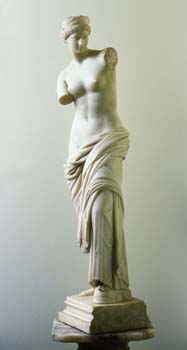Aphrodite/Venus
- n.d.
- Ernesto Gazzeri (Italian 1866-1965)
- Carved marble sculpture
107.8 x 29.1 x 21.3 cm., 42-3/8 x 11-1/2 x 8-1/2"
- Catherine Carter Goebel, Paul A. Anderson Chair in the Arts Purchase, Paul A. Anderson Art History Collection, Augustana College, 1999.21, pedestal not original to piece, 1999.23

Essay by Nick Dobson, Adjunct Instructor of Classics
Gazzeri’s work is a small version of the Aphrodite/Venus statue discovered in the eighteenth century in the ruins of a Roman theater in Capua. The original is currently in the National Archaeological Museum in Naples. The goddess of beauty, love, and sexuality is depicted wearing a crown, standing contrapposto (weight-shift) with one foot on a helmet. She is nude from the waist up, and richly detailed drapery slides from her hips. She turns her head to the left, and iconographic comparisons suggest that her now lost arms originally held a shield in which she gazed at her own reflection or recorded the details of a military triumph. The Roman statue dates to the Hadrianic period in the second century CE, but it is probably an adaptation of a lost Greek Hellenistic sculpture from the second century BCE, when sculptural nudes of Aphrodite in various poses became popular. The composition of a semi-nude Aphrodite holding a shield seems to synthesize elements of the famous Aphrodite Knidia of the fourth century BCE master Praxiteles and even earlier cult imagery of the goddess from Corinth.
Augustana’s undated sculpture reflects fascination with classical antiquity prevalent throughout Europe from the Renaissance through the early 20th century. The rediscovery of classical culture in the Renaissance led to avid collecting of ancient materials and plaster casts as prestige objects among European elites. By the 18th through 20th centuries this zeal to collect ancient works had been coopted by nation states in competition to stock national museums such as the Louvre and British Museum. Wider individual access to original pieces in large national collections, in turn, led to demand among the middle classes in many European countries for reproductions of classical art, and the expansion of public excavations at Pompeii and Herculaneum throughout the mid-eighteenth through nineteenth centuries fired the public’s imagination and desire for objects connected to the ancient Greeks and Romans. Gazzeri’s work would have been especially prized for its precious marble and artisan craft in a market dominated by mass produced bronzes.
